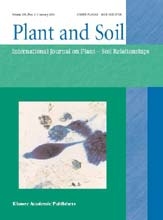| Journal Article |
 |
|
| Article Title | Gas-filled root porosity in response to temporary low oxygen supply in different growth stages | | Author | Meine van Noordwijk and Gerard Brouwer | | Year | 1993 | | Journal Title | Plant and Soil | | Institution | Kluwer Academic Publishers | | Volume | 152 | | Issue | 2 | | Pages | 187-199 | | Call Number | JA0061-04 | | Keywords | Aeration, Aerenchyma, Carnation, Cucumber, Gerbera, Maize, Oxygen stress, Oxygen transport, Redox dye, Rice, Rose, Sugar beet, Sweet pepper, Tomato, Wheat |
|
| Abstract: |
| Tomato cv. Moneymaker, maize cv. Brutus and Gerbera jamesonii cv. Fleur roots had a higher gas-filled root porosity (Ep (% v/v)) when grown permanently in a non-aerated than aerated solution. The Ep of roots increased during 2 weeks when half the root system of a young plant was transferred to a non-aerated solution; in older plants this response was not seen. Carnation cv. Silvery Pink plants had a negligible gas-filled porosity in all treatments. In a second experiment, a comparison was made between high (20 kPa) and low (approx equal to 2 kPa) O2 partial pressure in a recirculating nutrient solution. Half of the root system was transferred to low O2 at various growth stages. In most species older plants did not increase Ep on exposure to low O2. For tomato, Capsicum annuum and rose cv. Sonia plants Ep was normally in the range 3-8% (v/v). Young plants of cucumber cv. Corona, wheat cv. Minaret and sugarbeet cv. Regina also had Ep values in that range, but in older plants values ranged from 1 to 3%. Transverse root sections examined by light microscopy showed, on average, 60% more intercellular spaces in the root cortex than the measurements of gas-filled porosity, probably because some gaps and spaces in the cortex were not gas-filled. This effect was most pronounced in tomatoes. A negative pressure in the cortex may be needed for gaps to be gas-filled. An exodermis may increase the effectiveness of gas spaces in the cortex by closing the gas channels and, by offering some resistance to water uptake, allowing a negative pressure head in the cortex which keeps gaps gas-filled. A redox dye method was developed to study the length of root which is effectively supplied with oxygen, as a function of Ep. Results indicated that for every 1% Ep the root can remain aerated over at least 1 cm in a non-aerated medium under the conditions of the test
Descriptors:aeration. cortex. analytical-methods. maize. oxygen-transport. sugarbeet. wheat. tomatoes. cucumbers. carnations. roses. roots. physiology. anaerobiosis. vegetables. fruit-vegetables. ornamental-plants. ornamental-herbaceous-plants. ornamental-woody-plants |
|
|
Download file(s): Click icon to download/open file.
|
| |
File Size |
Description |

|
1,177 KB |
Softcopy |
|
|
|
| Viewed in 3542 times. Downloaded in 1093 times. |